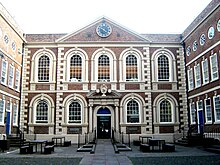Queen Anne style
The Queen Anne Style (also Queen Anne Revival Style ) is a British and American architectural style . It reached its widest distribution in the last quarter of the 19th century and is slightly different depending on the place of its development.
history
The Queen Anne style , which emerged from the 1870s, should not be confused with the architectural style that prevailed in British architectural history during the reign of Queen Anne (1702-14). The latter is a style founded by John Webb and Sir Christopher Wren that had evolved into a traditional localized classicism with a preference for brick facades .
The 19th century Queen Anne style, on the other hand, was introduced to the United Kingdom in the 1870s by architects George Devey and Richard Norman Shaw . Shaw published a book of architectural sketches in 1858. His suggestive ink drawings eventually appeared in trade and art magazines in the 1870s. American builders quickly adopted the style. The fact that Shaw's imaginative style got the name Queen Anne style , although it incorporated many other elements besides baroque, was probably due to a certain popularity of the "Queen Anne" in the late 1850s, such as the novel The History of Henry Esmond (1852 ) occupied by William Makepeace Thackeray . It is about a Colonel who is in the service of His Majesty Queen Anne . The combination of different materials, from delicate and warm brickwork with white painted wooden facades or light limestone, is one of the characteristics. This is also in common with the English architecture of Queen Anne's time. Bay windows, often several stacked, corner towers, asymmetrical facades and low-lying house entrances with wide canopies are preferred designs. In general, the Queen Anne style is characterized by a preference for picturesque asymmetries and picturesque buildings, which is as opposed to strict classicism as it is to strict neo-Gothic. The historical models were numerous: for example the Flemish, French and English Renaissance, also late Gothic elements. Instead of the rule-based imitation of a style, it was about its original, eclectic connection. A kind of free Renaissance style with a regional influence emerged. The British-Victorian variation of the style is more closely associated with the Arts and Crafts movement than the American one.
When a public architectural competition for a town hall in Wakefield was advertised in 1892 , the framework conditions for the competitors were kept very free, but it was noted by those responsible that the Queen Anne style with its modifications would fit well in a village like Wakefield . The design comes from James Gibson and Samuel Russell, both London architects, and essentially consists of a large corner tower with a domed roof and all sorts of ornaments.
United States

In the United States, the term Queen Anne style primarily refers to house and villa construction from 1880–1910. The free Renaissance forms and picturesque and picturesque elements distinguish it from the more pompous Beaux Arts style .
Canada
The Queen Anne style was also popular in Canada, which has closer cultural ties to England. A well-known example is the Central Chambers building in Ottawa .
Furniture style
A small byproduct of Thackeray's novel and Richard Norman Shaw's regional renaissance is the use of the term “Queen Anne” for a furniture style (“Queen Anne chair”). When in the early 1870s the English furniture of the mid-18th century, influenced by Chinese shapes, with curved furniture feet and walnut veneer, whose style could actually be described as "Georgian", they were mistakenly associated with the reign of Queen Anne. This misnomer persisted in both the United States and the United Kingdom to this day. Indeed, the furniture of Queen Anne's time (early 18th century) was in a Baroque style that can be classified as the William and Mary style.
swell
- This article is a translation of the article. T. added. en: Queen Anne style architecture , version of January 8, 2011.
- Wilfried Koch: Baustilkunde , Bertelsmann Lexikon Institut, 2003, ISBN 3-577-10457-0
literature
- Marc Girouard: Sweetness and Light: The Queen Anne Movement, 1860-1900 , Yale University Press, 1984.


